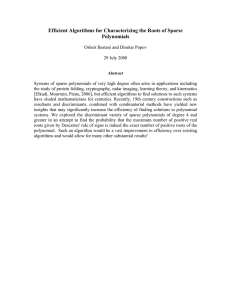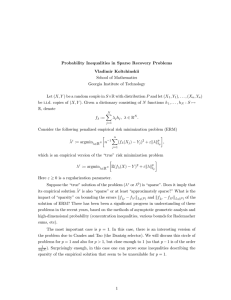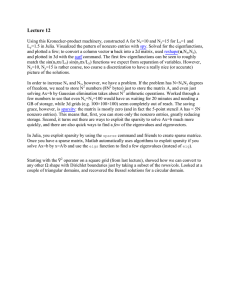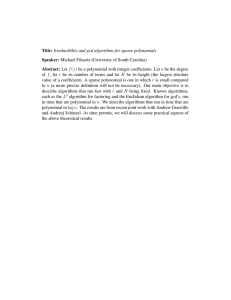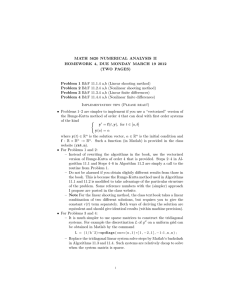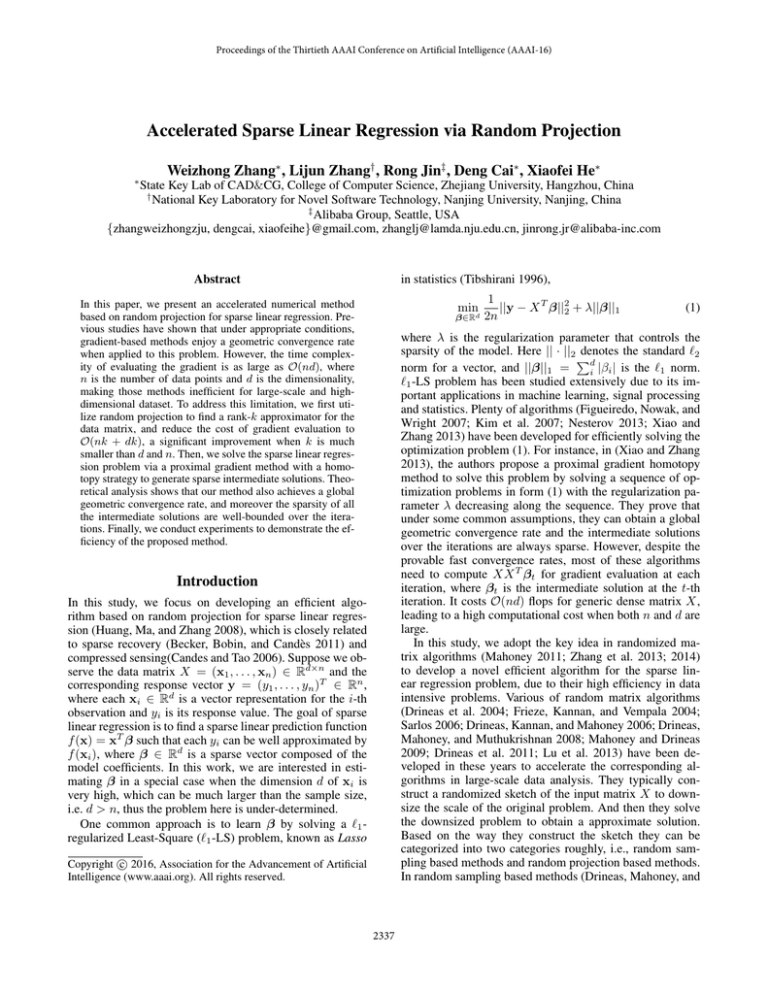
Proceedings of the Thirtieth AAAI Conference on Artificial Intelligence (AAAI-16)
Accelerated Sparse Linear Regression via Random Projection
∗
Weizhong Zhang∗ , Lijun Zhang† , Rong Jin‡ , Deng Cai∗ , Xiaofei He∗
State Key Lab of CAD&CG, College of Computer Science, Zhejiang University, Hangzhou, China
†
National Key Laboratory for Novel Software Technology, Nanjing University, Nanjing, China
‡
Alibaba Group, Seattle, USA
{zhangweizhongzju, dengcai, xiaofeihe}@gmail.com, zhanglj@lamda.nju.edu.cn, jinrong.jr@alibaba-inc.com
in statistics (Tibshirani 1996),
Abstract
min
In this paper, we present an accelerated numerical method
based on random projection for sparse linear regression. Previous studies have shown that under appropriate conditions,
gradient-based methods enjoy a geometric convergence rate
when applied to this problem. However, the time complexity of evaluating the gradient is as large as O(nd), where
n is the number of data points and d is the dimensionality,
making those methods inefficient for large-scale and highdimensional dataset. To address this limitation, we first utilize random projection to find a rank-k approximator for the
data matrix, and reduce the cost of gradient evaluation to
O(nk + dk), a significant improvement when k is much
smaller than d and n. Then, we solve the sparse linear regression problem via a proximal gradient method with a homotopy strategy to generate sparse intermediate solutions. Theoretical analysis shows that our method also achieves a global
geometric convergence rate, and moreover the sparsity of all
the intermediate solutions are well-bounded over the iterations. Finally, we conduct experiments to demonstrate the efficiency of the proposed method.
β∈Rd
1
||y − X T β||22 + λ||β||1
2n
(1)
where λ is the regularization parameter that controls the
sparsity of the model. Here || · ||2 denotes the standard 2
d
norm for a vector, and ||β||1 =
i |βi | is the 1 norm.
1 -LS problem has been studied extensively due to its important applications in machine learning, signal processing
and statistics. Plenty of algorithms (Figueiredo, Nowak, and
Wright 2007; Kim et al. 2007; Nesterov 2013; Xiao and
Zhang 2013) have been developed for efficiently solving the
optimization problem (1). For instance, in (Xiao and Zhang
2013), the authors propose a proximal gradient homotopy
method to solve this problem by solving a sequence of optimization problems in form (1) with the regularization parameter λ decreasing along the sequence. They prove that
under some common assumptions, they can obtain a global
geometric convergence rate and the intermediate solutions
over the iterations are always sparse. However, despite the
provable fast convergence rates, most of these algorithms
need to compute XX T βt for gradient evaluation at each
iteration, where βt is the intermediate solution at the t-th
iteration. It costs O(nd) flops for generic dense matrix X,
leading to a high computational cost when both n and d are
large.
In this study, we adopt the key idea in randomized matrix algorithms (Mahoney 2011; Zhang et al. 2013; 2014)
to develop a novel efficient algorithm for the sparse linear regression problem, due to their high efficiency in data
intensive problems. Various of random matrix algorithms
(Drineas et al. 2004; Frieze, Kannan, and Vempala 2004;
Sarlos 2006; Drineas, Kannan, and Mahoney 2006; Drineas,
Mahoney, and Muthukrishnan 2008; Mahoney and Drineas
2009; Drineas et al. 2011; Lu et al. 2013) have been developed in these years to accelerate the corresponding algorithms in large-scale data analysis. They typically construct a randomized sketch of the input matrix X to downsize the scale of the original problem. And then they solve
the downsized problem to obtain a approximate solution.
Based on the way they construct the sketch they can be
categorized into two categories roughly, i.e., random sampling based methods and random projection based methods.
In random sampling based methods (Drineas, Mahoney, and
Introduction
In this study, we focus on developing an efficient algorithm based on random projection for sparse linear regression (Huang, Ma, and Zhang 2008), which is closely related
to sparse recovery (Becker, Bobin, and Candès 2011) and
compressed sensing(Candes and Tao 2006). Suppose we observe the data matrix X = (x1 , . . . , xn ) ∈ Rd×n and the
corresponding response vector y = (y1 , . . . , yn )T ∈ Rn ,
where each xi ∈ Rd is a vector representation for the i-th
observation and yi is its response value. The goal of sparse
linear regression is to find a sparse linear prediction function
f (x) = xT β such that each yi can be well approximated by
f (xi ), where β ∈ Rd is a sparse vector composed of the
model coefficients. In this work, we are interested in estimating β in a special case when the dimension d of xi is
very high, which can be much larger than the sample size,
i.e. d > n, thus the problem here is under-determined.
One common approach is to learn β by solving a 1 regularized Least-Square (1 -LS) problem, known as Lasso
c 2016, Association for the Advancement of Artificial
Copyright Intelligence (www.aaai.org). All rights reserved.
2337
1
||X T βt − y||22 and Lt is a paramewhere f (βt ) = 2n
ter chosen at each iteration. The major computational efforts of them are used to compute the gradient ∇f (βt ) =
1
T
n X(X βt − y), which costs O(nd) flops for generic dense
matrix X.
Since in the under-determined case the object function is
not strongly convex, the convergence rate of the traditional
proximal gradient methods can only be O(1/T ), T is the iteration number. Some accelerated algorithms (Bioucas-Dias
and Figueiredo 2007; Wright, Nowak, and Figueiredo 2009;
Wen et al. 2010; Becker, Bobin, and Candès 2011) are then
proposed to improve the convergence rate to O(1/T 2 ) by
generating several concurrent sequences of iterates.
Recently, a proximal gradient homotopy method (Xiao
and Zhang 2013) is proposed to improve the efficiency of the
existing methods further. Its key idea is to solve a sequence
of 1 -LS problem over the stages with the values of the regularization parameter λ decreasing exponentially as the stage
goes on. The main benefit they get from the homotopy strategy is that all the solutions along the homotopy path are
sparse, which makes the objective function strongly convex
along this path. Thus, the convergence rate can be improved
to be geometric. The limitation of this method is that the
times it updates the solution in each intermediate problem
is unknown and always more than once. (Zhang et al. 2015)
adopt this idea to compressive sensing and in their approach
they update the solution only once for each regularization
parameter. However, different from our problem, the sensing matrix X in compressive sensing is pre-designed, like
sub-Gaussian random matrix. Thus, its theoretical analysis
may not be always true in our case. More importantly, the
computational complexity of each iteration is still O(nd) in
all these accelerated algorithms, which would be prohibitive
when both n and d are too large.
Muthukrishnan 2008; Mahoney and Drineas 2009; Drineas
et al. 2011), the sketch consists of some columns sampled
from the columns of X according to some specific probability distribution. While in random projection based methods,
the columns in the sketch are some linear combinations of
the columns from X. In our method, we adopt the random
projection method instead of the random sampling method,
since our problem is under-determined and sampling would
make it worse. To the best of our knowledge, it is the first attempt to exploit randomization for fast solving sparse linear
regression problems.
To be precise, we develop an efficient two-phase algorithm based on random projection for sparse linear regression. In phase one, we approximate X with a low rank
= (QW )T by using random projection, where
matrix X
Q ∈ Rn×k and W ∈ Rk×d . Thus XX T βt can be approximated by W T QT QW βt and in this way the computing cost can be reduced from O(nd) to O(dk + nk). When
k min{n, d}, this improvement in efficiency would be
significant. If the data matrix X is low rank or approximately
low rank, which is common in real applications, the matrix
would be a good approximator. In phase two, based on
X
we update the vector βt in each
the approximate matrix X,
iteration by employing a proximal gradient method using a
homotopy strategy, which is similar to the method in (Xiao
and Zhang 2013).
After giving the rough sketch of our method, we would
like to point out the main contributions of this work below:
• We reduce the computing complexity of each iteration
from O(nd) to O(dk + nk), meanwhile the global geometric convergence rate is preserved.
• Compared to the recent well known method (Xiao and
Zhang 2013), we need to run the composite gradient mapping only once for each regularization parameter.
Random Algorithms for Least Square Problem and
Low-rank Matrix Approximation
• The sparsity of the intermediate solutions in our approach
is well-bounded. The number of the nonzero entries in βt
is no more than two times of that in β∗ .
Below we briefly introduce some random matrix algorithms
for Least Square problem and Low-rank Approximation
problem since they are closely related to the key idea of our
method and they are at the center of the recent developments.
To accelerate the existing algorithms for least square
problem
1
||y − X T β||2 ,
(3)
min
β∈Rd 2n
Related Work
In this section, we briefly review the recent work on the optimization methods for 1 -LS problem, the random matrix
algorithms for least square problem and low-rank matrix approximation.
where X ∈ Rd×n , y ∈ Rn and β ∈ Rd , the researchers
(Drineas et al. 2011; Sarlos 2006) typically find an approximate solution by solving the following approximate problem
1
||Z(y − X T β)||2 ,
(4)
βopt = arg min
d
2n
β∈R
Previous Algorithms for 1 -LS Problem
Traditional methods (Daubechies, Defrise, and De Mol
2003; Nesterov 2013; Hale, Yin, and Zhang 2008; Wright,
Nowak, and Figueiredo 2009) developed in the past decades
for problem (1) are always based on composite gradient
mapping (Nesterov 2004) and we call them proximal gradient methods. Given the current solution βt , they update
the solution by using the following rule
where Z ∈ Rl×n is the data dependent matrix, the parameter l is usually much smaller than n. Since l n,
problem (4) has much smaller size compared to problem
(3). For random sampling based algorithms (Drineas et al.
2011), Z is a data dependent random sampling matrix constructed from an importance sampling distribution to capture the non-uniformity structure of X, which is defined by
βt+1 = arg min{f (βt ) + ∇f (βt )T (β − βt )
β
+
Lt
||β − βt ||22 + λ||β||1 },
2
(2)
2338
Preliminary and Notation
the statistical leverage scores (Mahoney and Drineas 2009).
And for random projection based algorithms (Drineas et al.
2011), it is a data-independent random projection for constructing the sketch and its elements are the coefficients of
the linear combinations. Recently, they show that by using random algorithm, they can find an approximate solu3
2
n
) time with the ertion β̃opt in O(dn log(d/) + d log
√ −2
ror ||β̃opt − βopt ||2 ≤ κ(X) γ − 1 ||βopt ||2 , here
κ(X) is the conditional number of X, γ is a parameter defining the amount of the mass of y inside the column space
of X T . Compared to the cost O(nd2 ) of the traditional
methods for the least square problem (3), such as Cholesky
decomposition, QR decomposition and Singular Value Decomposition (SVD), they are indeed much more efficient.
Different from our problem, the least square problem they
consider is overconstrained, i.e., n > d. In addition, they do
not care about the sparsity of the solution in their problem.
In Low-rank Matrix Approximation problems, given a
low rank d × n matrix X with rank(X) = r min{d, n},
to X of rank k
the goal is to find a good approximation X
with k ≤ r. As we know, we can obtain the best approxima from SVD with respect to the Frobenius norms. To
tion X
be precise, if we have the SVD of X, say X = U ΣV T ,
where U = (Uk , Uk,⊥ ) = [u1 , u2 , ..., ur ] ∈ Rd×r and
V = (Vk , Vk,⊥ ) = [v1 , v2 , ..., vr ] ∈ Rn×r are two column orthonormal matrices and Σ = diag(Σk , Σk,⊥ ) =
diag(σ1 , ..., σr ) ∈ Rr×r , σ1 ≥ σ2 ≥ ... ≥ σr > 0,
= Uk Σk V T is the best rank-k approximation to
then X
k
X. Since the computing complexity of SVD is typically
O(d2 n + n3 ), which is prohibitive in high dimensional
and data intensive applications, some random algorithms
(Drineas et al. 2004; Frieze, Kannan, and Vempala 2004;
Drineas, Kannan, and Mahoney 2006) are developed to accelerate this procedure. These methods usually use random
sampling (Drineas, Mahoney, and Muthukrishnan 2008;
Mahoney and Drineas 2009) or random projection to identify a subspace Ck that captures most of the actions of the
matrix X, then they project X to Ck to obtain the desired
The main steps of these methlow-rank approximation X.
ods are as follows:
In this section, we present the mathematical setups and a few
notions, which are necessary for the theoretical analysis of
our methods and also widely used in sparse linear regression, lasso and compressed sensing.
Firstly, we assume that there exists a sparse linear prediction function f∗ (x) = xT β∗ , where β∗ is a sparse vector
with ||β∗ ||0 = s d, such that each yi can be well approximated by f∗ (xi ). To this end, we define ε as the mean
squared regression error made by f∗ (·) over the training examples, i.e.
1
(f∗ (xi ) − yi )2 .
n i=1
n
ε2 :=
Since f∗ (·) is assumed to be an accurate prediction function,
we assume that ε is small. Our goal is to efficiently recover
the sparse vector β∗ and consequentially the sparse linear
prediction function f∗ (·).
Then, following the work (Koltchinskii 2011), we introduce a restricted eigenvalue condition and a restricted correlation (Bickel, Ritov, and Tsybakov 2009) for the feature
matrix X.
Definition 1 (Restricted Eigenvalue) Given an integer s >
0, we say that a matrix X satisfies the restricted eigenvalue
condition at sparsity level s if there exist positive constants
γ and γu such that
1
T
γ := inf √ ||X u||2 : ||u||2 = 1, ||u||0 ≤ s
n
1
T
γu := sup √ ||X u||2 : ||u||2 = 1, ||u||0 ≤ 2s .
n
Definition 2 (Restricted Correlation) We denote S(β) as
the support set of β, which is composed of the nonzero components of β. Given an integer s > 0, we define the restricted correlation of the data matrix X as
|β T XX T β |
: ||β||0 ≤ 2s,
ρ := max
|X T β|2 |X T β |2
||β ||0 ≤ s and S(β) ∩ S(β ) = ∅ .
• Generate the random sampling or random projection matrix Z ∈ Rn×(k+p) with p ≥ 0,
At last, we assume our data matrix X in the sequence
satisfies the restricted eigenvalue and restricted correlation
conditions with parameters γ , γu and ρ respectively.
• Compute the sketch C of X: C = XZ,
by projecting X
• Obtain the rank-k approximate matrix X
onto Ck : X = PCk X, where Ck is the best rank-k approximation to the matrix C, P is the projection operator.
Accelerated Sparse Linear Regression via
Random Projection
In these random algorithms, the relative error bound ||X −
≤ (1+)||X −PU X|| is often used to evaluate the preX||
k
cision of the random algorithms, here || · || is the Frobenius
norm or spectral of the matrix. Their computing complexity
can be reduced to O(dnk) or even O(dn log(k)) when Z is
a structured matrix, which is a quite significant improvement
in practice. In addition, compared to the traditional methods,
they are much more robust and can be reorganized to exploit
parallel computing architectures.
As described in the introduction section, our method is com for the
posed of two steps. It computes the approximation X
data matrix X at first. And then, using the homotopy strategy, it recovers the optimal pattern β∗ by solving a sequence
of subproblems in form (5). In this section, we will discuss
the key ideas and the detail steps (Algorithm 1) of our approach below.
In the first step, we utilize the randomized matrix algorithms to get a low-rank approximation for X efficiently. As
2339
Algorithm 1 Accelerated Sparse Linear Regression via Random Projection (SLRviaRP)
1: Input: the data matrix X, y, λ0 , λmin , γ, k, η
2: // Compute the approximation X:
3: Sample a d × k random matrix Z with Zij ∼ N (0, 1)
4: Compute the QR decomposition of X T Z, i.e., X T Z =
QR
= (XQ)QT = W T QT
5: Approximate X by X
6: // Recover the sparse vector β:
7: Initialize β0 = 0
8: for t = 0 to T − 1 do
9:
Update:
1
−X
T βt )
βt+1 = min − (β − βt )T X(y
n
β∈Rd
γ
+λt |β|1 + |β − βt |22
2
We will show that with appropriate choice of the parameters, we can accurately recover the true sparse solution β∗ .
And furthermore, the sparsity of the intermediate solutions
is well bounded, which leads to an additional improvement
on the computation besides the low rank matrix X.
Main Results
In this subsection, we present the theoretical results about
the convergence rate and the sparsity bound for our method.
For the space limitation, we postpone the detailed proofs to
the supplementary materials.
Firstly, we need the following theorem from (Halko, Martinsson, and Tropp 2011) to bound the difference between
the data matrix X and its approximator X.
Theorem 1 (Corollary 10.9 (Halko, Martinsson, and Tropp
2011)) Assume p = k − k0 ≥ 4, then it holds with failure
probability no more than 3e−p that
√
2 1/2
≤ 17 1 + k0 σk +1 + 8 k
σj
,
||X − X||
0
p+1
p+1
where λt = max(λmin , λ0 η t ).
10: end for
11: Return: βT
j>k0
where || · || stands for the spectral norm of matrix, σ1 ≥
σ2 ≥ . . . are the singular values of matrix X.
The theorem above shows that if X is low-rank or approx
imate low-rank that is most of the σi s are 0 or close to 0, X
would be a good approximator for X even we choose a small
integer k.
For the sake of convenience in the theoretical analysis be√
low, we denote δ as δ = ||X−X||/
n. From Theorem 1, we
know, in the cases where the data matrix X has a low-rank
or approximate row-rank structure, which is very common
in real applications, δ would always be a small number, i.e.,
δ = o( √1n ).
The following theorem demonstrates the sparsity of βt
over the iterations.
Theorem 2 Assume |S(βt ) \ S(β∗ )| ≤ s, and λt ≥
√2 max (γu + δ)(ε + δ||β∗ ||2 ), Λ||β∗ − βt ||2 , where Λ =
s
(2γu + δ)δ + ργu2 + max(|γ − γu2 |, |γ − γ2 |) . Then we can
have
|S(βt+1 ) \ S(β∗ )| ≤ s
In Theorem 2, the assumption |S(βt ) \ S(β∗ )| ≤ s when
t = 0 can be satisfied by initializing β0 as 0. Then by induction and choosing appropriate λt over the iterations, we can
have |S(βt+1 ) \ S(β∗ )| ≤ s for all t ∈ N. Thus the number
of non-zero elements in the intermediate solution βt is no
more than two times of that in β∗ and the sparsity of βt is
consequentially well-bounded.
At last, we present the convergence rate of our method in
the theorem below.
Theorem
3 Suppose ||βt − β∗ ||2 ≤ max (e0 , θt ) and η =
√
4 s
Λ
<
1,
we let
γ
λt = 2 max (γu + δ)(ε + δ||β∗ ||2 ), Λ max (e0 , θt ) ,
√
where e0 = 4 s(γu + δ)(ε + δ||β∗ ||2 )/γ and Λ is inherited
from the theorem above. Then we have
||βt+1 − β∗ ||2 ≤ max e0 , θt+1 with θt+1 = ηθt .
our problem is highly under-determined since n < d, random sampling will make it worse. Thus, we adopt random
projection instead of random sampling based method to ap (see Algorithm 4.1
proximate X with a low rank matrix X
in (Halko, Martinsson, and Tropp 2011)). We first compute
a Gaussian random matrix Z ∈ Rd×k , where k d and
each entry Zi,j is sampled independently from an Gaussian
distribution N (0, 1). We then compute the QR decomposition of X T Z, i.e. X T Z = QR, where Q ∈ Rn×k is an
orthogonormal matrix of rank k and R ∈ Rk×k is an upper triangle matrix. Actually, Q is composed of some orthogonal basis of X T . We finally approximate X by projecting X T to the space spanned by the columns of Q, i.e.,
= XQQT = W T QT , where W = (XQ)T ∈ Rk×d .
X
At last, we should note here that the QR decomposition for
X T Z can be computed in 2nk 2 floating-point calculations,
which is acceptable when k is relatively small. And in many
real applications, the data matrix X is always a low-rank or
is still an accurate apapproximately low-rank matrix, so X
proximator for X even when we set k to be a small integer.
We will certify this phenomenon in Theorem 1.
In the second step, given the approximate low rank ma returned by the first step, we recover the sparse linear
trix X
model β∗ by a simple first order method with a homotopy
strategy. At iteration t, given the current solution βt , we update it by solving the following optimization problem
1
−X
T βt )
βt+1 = min {− (β − βt )T X(y
n
β∈Rd
γ
+λt |β|1 + |β − βt |22 }
(5)
2
where γ is a constant whose value will be discussed later,
and λt = λ0 η t is an adaptive regularization parameter that
usually declines over the iterations, where η ∈ (0, 1) controls the shrinkage speed of λt .
2340
Theorem 3 shows that by appropriately choosing the value
of λt according to this theorem, we can get ||βt − β∗ ||2 ≤
max (e0 , θt ) = max (e0 , η t θ0 ). Furthermore, from the definition of Λ, it is clear that we can make 0 < η < 1 if appropriate γ is chosen. Thus a global geometric convergence
rate is obtained until we get ||βt+1 − β∗ ||2 ≤ e0 . From the
definition of e0 , we can see that since both δ and are small
numbers, we can recover β∗ accurately.
At last, we notice the fact that λt can be rewritten
as λt = 2 max max ((γu + δ)(ε + δ||β∗ ||2 ), Λe0 ) , Λθt .
Hence we can let λt = max(λmin , λ0 η t ) with λmin =
2 max ((γu + δ)(ε + δ||β∗ ||2 ), Λe0 ), just as we set in the
Algorithm 1.
At the end of this section, we would like to conclude some
properties of our approach. 1) We only need O(dk + nk)
flops at each iteration to update the βt instead of O(dn)
in traditional methods. It is a significant improvement when
both d and n are much larger than k. 2) A global geometric
convergence rate is achieved. 3) The sparsity of intermediate solution βt is well bounded, that is the number of the
nonzero entries in βt is no more than two times of that in
β∗ . 4) Compared to (Xiao and Zhang 2013), we only need
to update βt only once a for each λt .
3) The response vector is sampled from the prediction
model y = X T β∗ + ey , where ey ∈ RN is a random noise
vector sampled from a normal distribution N (0, σe2y IN ×N ).
Parameter setting For the training data, we set d =
10000, N = 5000, k = 500, s = 25 and vary the noise
level eX , ey in [0.01, 0.02, ..., 0.05]. In ADG, Ψ(x) =
0.001||β||1 , γμ = γd = 1.5, μ = 0 and L0 = 0.001. In
PGH, we set λtgt = 0.001, = 10−6 , Lmin = 10−6 , η =
0.7, δ = 0.2 and γdec = γinc = 2. At last, for our method
SLviaRP, we let γ = λ0 = 0.3, η = 0.94 and λmin = 0.002.
Goal To recover the optimal sparse vector β∗ from the training data X and y both accurately and efficiently. And also,
the solutions we obtain should be as sparse as possible.
Evalation metrics To evaluate the property of the learning
βT , we measure the error ||βt − β∗ ||2 and its sparsity over
the iterations and the running time (second). The sparsity
d
here is computed as density = d1 i=1 I([βT ]i = 0). And
we also measure the recovery of the support set of βT by
SSR(βT ) = 2|S(βT ) ∩ S(β∗ )|/|S(βT )| + |S(β∗ )|. We run
each experiment 100 times, and report the averaged results.
Experimental results Figures 1 and 2 show the performances of different algorithms when the noise level eX =
eY = 0.01. From the left panels of both Figure 1 and 2,
we observe that our method converges to the optimal solution β∗ as fast as the recent algorithm PGH, thus their
convergence rates are comparable. The right panels give us
a deep impression that we can improve run-time efficiency
significantly due to the lower computing complexity at each
iteration. In addition, it shows that ADG is not good at
dealing with such under-determined problem, since its error ||βt − β∗ ||2 decreases slowly over the iterations. It may
result from the fact that its solution path is not sparse (Table
1) over the iterations (Xiao and Zhang 2013).
Having analysed the performance of the proposed method
in the theoretical perspective, now we turn to the empirical
study that how the proposed method behaves.
We follow the work (Xiao and Zhang 2013) and evaluate
the performance of our method mainly on two aspects: (i)
The speed of the learned vector βt converging to the optimal
solution β∗ . (ii) The sparsity of the learned vector βT . And
two baseline algorithms below will be used in our study.
• ADG ((Nesterov 2013), Algorithm 4.9): Nesterov’s accelerated dual gradient method.
5
SLRviaRP
PGH
ADG
3
• SLviaRP: the proposed method in our study.
Experiments on the Synthesized Datasets
1
0
−1
−2
Dataset We generate the data matrix X, the response vector
y and the optimal solution β∗ in the following way:
1) For the data matrix X, we generate it by adding a Gaussian noise eX to a low rank matrix X0 , i.e. X = X0 + eX ,
where eX ∈ Rd×N , [eX ]ij ∼ N (0, σe2X ). For generating
the matrix X0 , we first construct a random matrix U ∈
Rd×N , each Uij is sampled from an uniform distribution
U[−1,1] . Then, we calculate a QR factorization for U , i.e.
U = QR, Q ∈ Rd×N , R ∈ RN ×N . We extract the first
k columns from Q to form a new matrix Q̂. At last, we
get the low rank matrix X0 by projecting U onto Q̂, i.e.,
X0 = Q̂Q̂T U .
2) For the sparse vector β∗ ∈ Rd , we select s components
from its d coordinates randomly and set them to 1. Then we
set all the rest components to 0.
SLRviaRP
PGH
ADG
4
3
2
t
2
t
* 2
error log(||beta −beta || )
• PGH (Xiao and Zhang 2013): a state-of-art algorithm
yields a global geometric convergence rate.
5
* 2
4
error log(||beta −beta || )
Experiment Study
−3
20
1
0
−1
−2
40
60
Iterations
80
100
−3
0
50
100
150
Running Time
200
Figure 1: The error log(||βt −β∗ ||2 ) over the iterations (left)
and running time (right) with eX = eY = 0.05.
Table 1 summarizes the evaluation results for final solutions output from different algorithms after 100 iterations under different noise levels eX and eY . For PGH and
SLRviaRP, we observe that they have similar performances
at convergence and sparsity preserving, since the values of
the metrics, like the residual, the error, density and SSR are
all comparable. More importantly, it is confirmed by the time
cost of each method that our method is much more efficient
than others (roughly 70 times faster in this case).
2341
2
2
SLRviaRP
PGH
ADG
t 2
−1
−2
−3
−4
−5
−6
−7
20
Table 1: Results with d = 10000, N = 5000, k = 500.
eX = 0.01, eY = 0.01
Method
Res
Error
density SSR
time
ADG
0.026 24.566 0.7363 0.007 138.2
PGH
0.001 0.107
0.0025 0.996 134.7
SLRviaRP 0.001 0.111
0.0025 0.995
2.4
eX = 0.02, eY = 0.02
Method
Res
Error
density SSR
time
ADG
0.066 22.132 0.7400 0.007 143.7
PGH
0.001 0.108
0.0025 0.997 147.3
SLRviaRP 0.001 0.115
0.0025 0.994
2.3
eX = 0.03, eY = 0.03
Method
Res
Error
density SSR
time
ADG
0.091 20.718 0.7524 0.007 148.9
PGH
0.001 0.107
0.0025 0.993 157.5
SLRviaRP 0.001 0.119
0.0026 0.989
1.9
eX = 0.04, eY = 0.04
Method
Res
Error
density SSR
time
ADG
0.098 20.13
0.7700 0.006 146.2
PGH
0.001 0.106
0.0025 0.991 149.1
SLRviaRP 0.001 0.124
0.0027 0.971
1.9
eX = 0.05, eY = 0.05
Method
Res
Error
density SSR
time
ADG
0.104 20.478 0.7942 0.006
148
PGH
0.002 0.106
0.0026 0.988 153.8
SLRviaRP 0.002 0.127
0.0027
0.97
2.1
SLRviaRP
PGH
ADG
1
residual log(||y−Xbeta ||2/2N)
0
2
t 2
residual log(||y−Xbeta || /2N)
1
0
−1
−2
−3
−4
−5
−6
40
60
Iterations
80
−7
0
100
50
100
150
Running Time
200
Figure 2: The residual log(||y − Xβt ||22 /2N ) over the iterations (left) and running time (right) with eX = eY = 0.05.
Figure 3 shows the performance of our method under different shrinkage rates η ∈ [0.91, 0.92, ..., 0.95]. It reflects
the insensitivity of our method to the parameter.
error log(||betat−beta*||)
1
0.5
0
−0.5
−1
−1.5
1
−1
−2
−3
−4
−5
−6
−2
−2.5
20
eta=0.95
eta=0.94
eta=0.93
eta=0.92
eta=0.91
0
t
eta=0.95
eta=0.94
eta=0.93
eta=0.92
eta=0.91
residual log(||y−Xbeta ||2/2N)
2
1.5
40
60
Iterations
80
100
−7
20
40
60
Iterations
80
100
Experimental Result According to Table 2, it is obvious
that our method has great superiority in efficiency over the
baseline algorithms. And compared to PGH, our method has
comparable sparse learning ability. The relatively big residual and the bad sparsity of ADG show that it is not good
at dealing with such under-determined problem, which consists with the result in the last experiment.
Figure 3: The error log(||βt − β∗ ||2 ) (left) and the residual
log(||y − Xβt ||22 /2N ) (right) of our method over the iterations with different shrinkage rate η and eX = eY = 0.05.
Experiments on Real-word Dataset
Experiment design To demonstrate the efficiency of our
methods further, we conduct a regression experiment on the
well-known dataset MNIST, comprised of the gray images
of scanned handwritten digits. It has roughly 60000 training
samples and 10000 testing samples. The dimension of each
sample is 28 × 28. We randomly sample 10,000 examples
from the training set and get a data matrix X ∈ R10,000×784 .
At last, we obtain the response vector y ∈ R784 by sampling
an image from the testing set. Our goal is to find a sparse
vector β which can approximate y with X T β accurately.
Parameter setting In ADG, Ψ(x) = 0.0005||β||1 , γμ =
γd = 1.2, μ = 0 and L0 = 0.001. In PGH, we set λtgt =
0.005, = 0.001, Lmin = 0.005, η = 0.7, δ = 0.7 and
γdec = γinc = 2. For our method SLviaRP, we let k =
100, γ = 10, λ0 = 0.2, η = 0.97 and λmin = 0.005. At
last, we run 100 trials and report the averaged performance
of each method after 1000 iterations.
Evalation metrics Since the optimal solution β∗ is unknown, we use the metrics like residual, sparsity and running time to evaluate the performance of our method. And
summarize the numerical results in Table 2.
Table 2: Numerical results on MNIST.
Method
Res
density time
ADG
0.022 0.9982 48.3
PGH
0.004 0.0046 63.8
SLRviaRP 0.005 0.0036
0.7
Conclusion
In this paper, we propose a novel sparse linear regression
method based on random projection. In our method, we reduce the complexity for evaluating the gradient at each iteration from O(nd) to O(nk +dk) by using random projection.
And then,we adopt a proximal gradient method to solve the
sparse linear regression problem with a homotopy strategy.
We verify, both theoretically and experimentally, that our
method achieves a geometric convergence and can significantly improve the time-efficiency of the existing methods
for sparse linear regression. In addition, the sparsity of our
intermediate solutions is well-bounded.
2342
Acknowledgments
Kim, S.-J.; Koh, K.; Lustig, M.; Boyd, S.; and Gorinevsky,
D. 2007. An interior-point method for large-scale l 1regularized least squares. Selected Topics in Signal Processing, IEEE Journal of 1(4):606–617.
Koltchinskii, V. 2011. Oracle Inequalities in Empirical Risk
Minimization and Sparse Recovery Problems: Ecole dEté
de Probabilités de Saint-Flour XXXVIII-2008, volume 2033.
Springer.
Lu, Y.; Dhillon, P.; Foster, D. P.; and Ungar, L. 2013. Faster
ridge regression via the subsampled randomized hadamard
transform. In Advances in Neural Information Processing
Systems, 369–377.
Mahoney, M. W., and Drineas, P. 2009. Cur matrix decompositions for improved data analysis. Proceedings of
the National Academy of Sciences 106(3):697–702.
Mahoney, M. W. 2011. Randomized algorithms for matrices
R in Machine Learning
and data. Foundations and Trends
3(2):123–224.
Nesterov, Y. 2004. Introductory lectures on convex optimization: A basic course, volume 87. Springer.
Nesterov, Y. 2013. Gradient methods for minimizing composite functions. Mathematical Programming 140(1):125–
161.
Sarlos, T. 2006. Improved approximation algorithms for
large matrices via random projections. In Foundations of
Computer Science, 2006. FOCS’06. 47th Annual IEEE Symposium on, 143–152. IEEE.
Tibshirani, R. 1996. Regression shrinkage and selection via
the lasso. Journal of the Royal Statistical Society. Series B
(Methodological) 267–288.
Wen, Z.; Yin, W.; Goldfarb, D.; and Zhang, Y. 2010. A
fast algorithm for sparse reconstruction based on shrinkage,
subspace optimization, and continuation. SIAM Journal on
Scientific Computing 32(4):1832–1857.
Wright, S. J.; Nowak, R. D.; and Figueiredo, M. A. 2009.
Sparse reconstruction by separable approximation. Signal
Processing, IEEE Transactions on 57(7):2479–2493.
Xiao, L., and Zhang, T. 2013. A proximal-gradient homotopy method for the sparse least-squares problem. SIAM
Journal on Optimization 23(2):1062–1091.
Zhang, L.; Mahdavi, M.; Jin, R.; Yang, T.; and Zhu, S. 2013.
Recovering the optimal solution by dual random projection.
In Proceedings of the 26th Annual Conference on Learning
Theory, 135–157.
Zhang, L.; Mahdavi, M.; Jin, R.; Yang, T.; and Zhu, S. 2014.
Random projections for classification: A recovery approach.
Information Theory, IEEE Transactions on 60(11):7300–
7316.
Zhang, L.; Yang, T.; Jin, R.; and Zhou, Z.-H. 2015. A simple
homotopy algorithm for compressive sensing. In Proceedings of the Eighteenth International Conference on Artificial
Intelligence and Statistics, 1116–1124.
This work was supported in part by National Basic Research Program of China (973 Program) under Grant
2013CB336500, National Natural Science Foundation of
China under Grants (61125203, 61233011) and National
Program for Special Support of Top-Notch Young Professionals.
References
Becker, S.; Bobin, J.; and Candès, E. J. 2011. Nesta: a fast
and accurate first-order method for sparse recovery. SIAM
Journal on Imaging Sciences 4(1):1–39.
Bickel, P. J.; Ritov, Y.; and Tsybakov, A. B. 2009. Simultaneous analysis of lasso and dantzig selector. The Annals of
Statistics 1705–1732.
Bioucas-Dias, J. M., and Figueiredo, M. A. 2007. A new
twist: two-step iterative shrinkage/thresholding algorithms
for image restoration. Image Processing, IEEE Transactions
on 16(12):2992–3004.
Candes, E. J., and Tao, T. 2006. Near-optimal signal recovery from random projections: Universal encoding strategies?
Information Theory, IEEE Transactions on 52(12):5406–
5425.
Daubechies, I.; Defrise, M.; and De Mol, C. 2003. An iterative thresholding algorithm for linear inverse problems with
a sparsity constraint. arXiv preprint math/0307152.
Drineas, P.; Frieze, A.; Kannan, R.; Vempala, S.; and Vinay,
V. 2004. Clustering large graphs via the singular value decomposition. Machine learning 56(1-3):9–33.
Drineas, P.; Mahoney, M. W.; Muthukrishnan, S.; and
Sarlós, T. 2011. Faster least squares approximation. Numerische Mathematik 117(2):219–249.
Drineas, P.; Kannan, R.; and Mahoney, M. W. 2006. Fast
monte carlo algorithms for matrices ii: Computing a lowrank approximation to a matrix. SIAM Journal on Computing 36(1):158–183.
Drineas, P.; Mahoney, M. W.; and Muthukrishnan, S. 2008.
Relative-error cur matrix decompositions. SIAM Journal on
Matrix Analysis and Applications 30(2):844–881.
Figueiredo, M. A.; Nowak, R. D.; and Wright, S. J. 2007.
Gradient projection for sparse reconstruction: Application
to compressed sensing and other inverse problems. Selected
Topics in Signal Processing, IEEE Journal of 1(4):586–597.
Frieze, A.; Kannan, R.; and Vempala, S. 2004. Fast montecarlo algorithms for finding low-rank approximations. Journal of the ACM (JACM) 51(6):1025–1041.
Hale, E. T.; Yin, W.; and Zhang, Y. 2008. Fixed-point
continuation for l1-minimization methodology and convergence. SIAM Journal on Optimization 19(3):1107–1130.
Halko, N.; Martinsson, P.-G.; and Tropp, J. A. 2011. Finding
structure with randomness: Probabilistic algorithms for constructing approximate matrix decompositions. SIAM review
53(2):217–288.
Huang, J.; Ma, S.; and Zhang, C.-H. 2008. Adaptive lasso
for sparse high-dimensional regression models. Statistica
Sinica 18(4):1603.
2343

